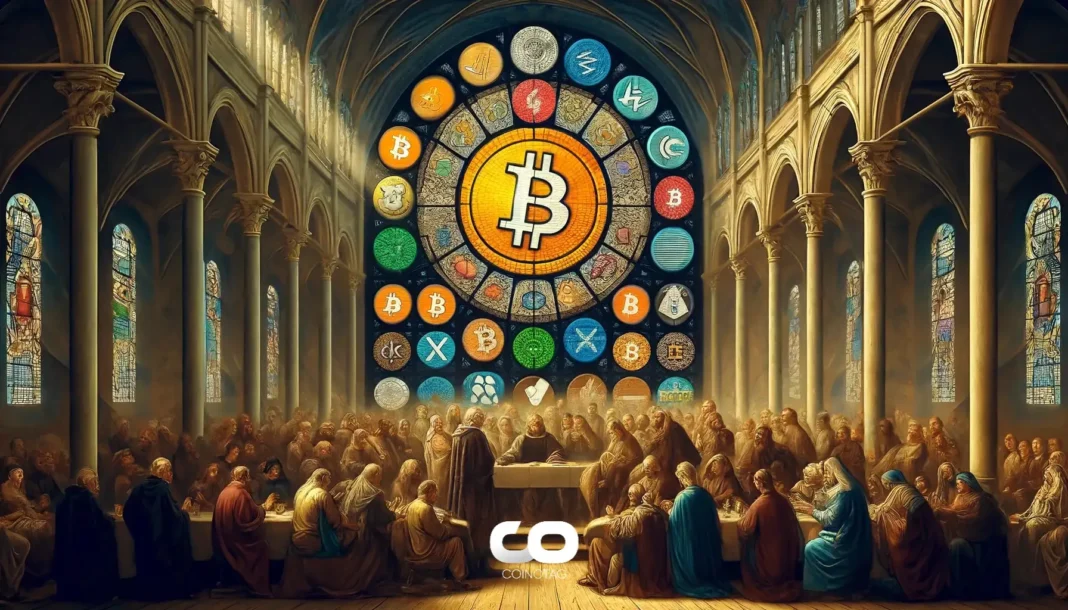| COINOTAG recommends • Exchange signup |
| 💹 Trade with pro tools |
| Fast execution, robust charts, clean risk controls. |
| 👉 Open account → |
| COINOTAG recommends • Exchange signup |
| 🚀 Smooth orders, clear control |
| Advanced order types and market depth in one view. |
| 👉 Create account → |
| COINOTAG recommends • Exchange signup |
| 📈 Clarity in volatile markets |
| Plan entries & exits, manage positions with discipline. |
| 👉 Sign up → |
| COINOTAG recommends • Exchange signup |
| ⚡ Speed, depth, reliability |
| Execute confidently when timing matters. |
| 👉 Open account → |
| COINOTAG recommends • Exchange signup |
| 🧭 A focused workflow for traders |
| Alerts, watchlists, and a repeatable process. |
| 👉 Get started → |
| COINOTAG recommends • Exchange signup |
| ✅ Data‑driven decisions |
| Focus on process—not noise. |
| 👉 Sign up → |
-
Binance has unveiled its new “Vote to List” and “Vote to Delist” features, marking a significant shift toward community involvement in token listings.
-
This initiative allows users to vote on pre-selected tokens within Binance’s “Alpha Observation Zone,” reinforcing transparency and stakeholder engagement.
-
“This new governance mechanism will provide users more influence over the tokens listed on our platform,” stated a spokesperson from Binance.
Binance launches community voting for token listings, encouraging greater transparency and involvement from users while maintaining oversight on eligible tokens.
Binance to Host Token Listing Votes
As the largest crypto exchange globally, Binance’s influence on token valuations is undeniable. Historically, announcements of new listings have consistently resulted in price surges for the affected assets, yet the entire process has often been shrouded in opacity.
Now, after a period of reflection and user feedback, Binance is taking steps to improve transparency by introducing community-based votes to guide token listings:
“Binance is enhancing its listing mechanism and introducing its new Community Co-Governance Mechanism for Listings. The ‘Vote to List’ and ‘Vote to Delist’ mechanisms will enable greater community participation and give users a stronger voice in the listing process,” the exchange stated on social media.
| COINOTAG recommends • Professional traders group |
| 💎 Join a professional trading community |
| Work with senior traders, research‑backed setups, and risk‑first frameworks. |
| 👉 Join the group → |
| COINOTAG recommends • Professional traders group |
| 📊 Transparent performance, real process |
| Spot strategies with documented months of triple‑digit runs during strong trends; futures plans use defined R:R and sizing. |
| 👉 Get access → |
| COINOTAG recommends • Professional traders group |
| 🧭 Research → Plan → Execute |
| Daily levels, watchlists, and post‑trade reviews to build consistency. |
| 👉 Join now → |
| COINOTAG recommends • Professional traders group |
| 🛡️ Risk comes first |
| Sizing methods, invalidation rules, and R‑multiples baked into every plan. |
| 👉 Start today → |
| COINOTAG recommends • Professional traders group |
| 🧠 Learn the “why” behind each trade |
| Live breakdowns, playbooks, and framework‑first education. |
| 👉 Join the group → |
| COINOTAG recommends • Professional traders group |
| 🚀 Insider • APEX • INNER CIRCLE |
| Choose the depth you need—tools, coaching, and member rooms. |
| 👉 Explore tiers → |
While this move does not create a fully democratic system, it significantly enhances user engagement. Binance will select only those projects in its “Alpha Observation Zone” for voting, which means the community can only vote on a limited selection of tokens.
Moreover, to protect the integrity of the process, any token seeking approval for listing must first pass Binance’s strict due diligence evaluations. Similar requirements will apply to tokens being considered for delisting, thus maintaining oversight by the exchange.
| COINOTAG recommends • Exchange signup |
| 📈 Clear interface, precise orders |
| Sharp entries & exits with actionable alerts. |
| 👉 Create free account → |
| COINOTAG recommends • Exchange signup |
| 🧠 Smarter tools. Better decisions. |
| Depth analytics and risk features in one view. |
| 👉 Sign up → |
| COINOTAG recommends • Exchange signup |
| 🎯 Take control of entries & exits |
| Set alerts, define stops, execute consistently. |
| 👉 Open account → |
| COINOTAG recommends • Exchange signup |
| 🛠️ From idea to execution |
| Turn setups into plans with practical order types. |
| 👉 Join now → |
| COINOTAG recommends • Exchange signup |
| 📋 Trade your plan |
| Watchlists and routing that support focus. |
| 👉 Get started → |
| COINOTAG recommends • Exchange signup |
| 📊 Precision without the noise |
| Data‑first workflows for active traders. |
| 👉 Sign up → |
Previously, community votes on token listings were rare occurrences. Just last month, Binance allowed a vote regarding the listing of Pi Network, which received substantial community support, although the actual listing remains pending.
Looking forward, this structured voting process could emerge as an integral component of Binance’s broader due diligence protocols regarding new listings.
| COINOTAG recommends • Traders club |
| ⚡ Futures with discipline |
| Defined R:R, pre‑set invalidation, execution checklists. |
| 👉 Join the club → |
| COINOTAG recommends • Traders club |
| 🎯 Spot strategies that compound |
| Momentum & accumulation frameworks managed with clear risk. |
| 👉 Get access → |
| COINOTAG recommends • Traders club |
| 🏛️ APEX tier for serious traders |
| Deep dives, analyst Q&A, and accountability sprints. |
| 👉 Explore APEX → |
| COINOTAG recommends • Traders club |
| 📈 Real‑time market structure |
| Key levels, liquidity zones, and actionable context. |
| 👉 Join now → |
| COINOTAG recommends • Traders club |
| 🔔 Smart alerts, not noise |
| Context‑rich notifications tied to plans and risk—never hype. |
| 👉 Get access → |
| COINOTAG recommends • Traders club |
| 🤝 Peer review & coaching |
| Hands‑on feedback that sharpens execution and risk control. |
| 👉 Join the club → |
The shift towards transparency comes at a critical time for Binance, which has faced scrutiny over recent listing choices involving lesser-known meme coins. Critics expressed concerns regarding potential market manipulation, where less scrupulous practices like pump-and-dump schemes emerged. Through voting, Binance aims to restore user confidence by empowering the community.
However, it is essential to recognize that Binance retains its decision-making autonomy. The firm can still act independently, which could lead to mixed signals within the community. For instance, just yesterday, Binance planned to list RedStone’s RED token but suspended the process in response to community backlash regarding changes to its airdrop terms, highlighting how community feedback can influence actions.
Ultimately, the introduction of community-driven voting mechanisms may pave the way for increased transparency and stakeholder trust within the exchange, fostering a more robust and engaged user community.
Conclusion
With the launch of community voting for token listings, Binance is taking a significant step towards enhancing transparency and participation in its platform. While retaining control over the final decisions, this initiative could improve user trust and help stabilize the exchange’s reputation following recent controversies. A more engaged community can contribute positively, both to token evaluations and Binance’s overall credibility within the cryptocurrency space.
| COINOTAG recommends • Exchange signup |
| 📈 Clear control for futures |
| Sizing, stops, and scenario planning tools. |
| 👉 Open futures account → |
| COINOTAG recommends • Exchange signup |
| 🧩 Structure your futures trades |
| Define entries & exits with advanced orders. |
| 👉 Sign up → |
| COINOTAG recommends • Exchange signup |
| 🛡️ Control volatility |
| Automate alerts and manage positions with discipline. |
| 👉 Get started → |
| COINOTAG recommends • Exchange signup |
| ⚙️ Execution you can rely on |
| Fast routing and meaningful depth insights. |
| 👉 Create account → |
| COINOTAG recommends • Exchange signup |
| 📒 Plan. Execute. Review. |
| Frameworks for consistent decision‑making. |
| 👉 Join now → |
| COINOTAG recommends • Exchange signup |
| 🧩 Choose clarity over complexity |
| Actionable, pro‑grade tools—no fluff. |
| 👉 Open account → |
| COINOTAG recommends • Members‑only research |
| 📌 Curated setups, clearly explained |
| Entry, invalidation, targets, and R:R defined before execution. |
| 👉 Get access → |
| COINOTAG recommends • Members‑only research |
| 🧠 Data‑led decision making |
| Technical + flow + context synthesized into actionable plans. |
| 👉 Join now → |
| COINOTAG recommends • Members‑only research |
| 🧱 Consistency over hype |
| Repeatable rules, realistic expectations, and a calmer mindset. |
| 👉 Get access → |
| COINOTAG recommends • Members‑only research |
| 🕒 Patience is an edge |
| Wait for confirmation and manage risk with checklists. |
| 👉 Join now → |
| COINOTAG recommends • Members‑only research |
| 💼 Professional mentorship |
| Guidance from seasoned traders and structured feedback loops. |
| 👉 Get access → |
| COINOTAG recommends • Members‑only research |
| 🧮 Track • Review • Improve |
| Documented PnL tracking and post‑mortems to accelerate learning. |
| 👉 Join now → |







